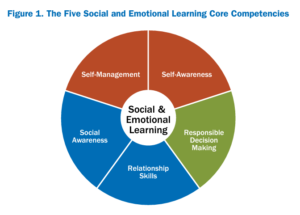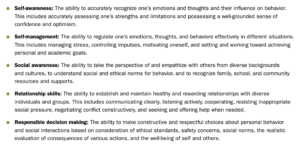Written by: Kalin Goble, M.S.
Last month, I completed my first volunteering cycle with a local restorative justice program for teens. Twice a week, we meet and come together in a circle. We begin each meeting with a self-connection check-in. We are guided to close our eyes, take a deep breath, and pay attention to our surroundings…all to hone in on our feelings.
This self-connection practice is rooted in social-emotional learning (SEL) practice. Developing strong social-emotional learning skills can be a protective factor for children and youth and help lead to successful relationships and interactions.
SEL consists of five components. Those core competencies are:

 (CASEL, 2013)
(CASEL, 2013)
Read more on Effective Social and Emotional Learning Programs from the 2013 CASEL Guide for more information on SEL in preschool and elementary settings.
Cornerstone for Emotional Connection
The first SEL component is self-awareness. By being comfortable in connecting with our feelings first, we strengthen the skills needed to identify, recognize, and manage our emotions in our interactions with others. Thus, self-awareness is the first step in building the capacity for emotional knowledge, emotional regulation, perspective-taking, and empathy (McClelland, et. al., 2017).
So, how can this relate to your work in supporting military families and supporting both adults and youth?
Allow Space for Everyone to Create a Safe Environment
Throughout the cycle, we use self-connection to get comfortable sharing our feelings and to create a safe space for all participants. We consistently practice this. Everyone shares how they are feeling. The volunteers, the program coordinator, case managers, and the teens. By being consistent and getting comfortable with sharing our feelings, we then build on more intricate communication skills later in the cycle.
If a child, teen, or parent struggles to communicate their feelings and needs, beginning your interactions with a self-connection may help open up the dialogue.
Start Small
You may start your sessions by asking your client to close their eyes, take a deep breath, scan their body, listen to the sounds around them, and think about what information they get. What are they feeling? Are they excited? Open? Happy? Hopeful? Exhausted? Fatigued? Reluctant?
We use the John Kinyon Feelings and Needs sheet in my program. This sheet helps us articulate our feelings. But as our Practicing Connection team explores in their podcast episode Using the Feeling Wheel to Know Your Emotions, a variety of free resources are available to guide you in identifying emotions.
Once we have established comfort in identifying our feelings, we then use it to inform our needs (and whether our needs have or have not been met). These skills all work together to promote a positive environment of sharing and connecting.
For more details on SEL strategies and resources to promote youth resilience and coping skills, you can watch our OneOp webinar, Promoting Youth Mental Well-Being by Building Social-Emotional Learning Skills.
In Conclusion…
Social and emotional learning (SEL) programs lead to measurable and potentially long-lasting improvements in many areas of children’s lives (Greenberg, et. al., 2017). Self-connection is a simple pause in your daily interactions that strengthens SEL capacities.
Engaging parents and children/youth alike in connecting with feelings equips them with tools to pause throughout their day, identify, and hopefully regulate their feelings and emotions. Connecting with yourself through articulating one’s feelings can help in connecting with the world around us. By starting small, we can nourish safety in processing emotions and increasing healthy communication internally (within ourselves) and externally (in our relationships and interactions with others).
References
Collaborative for Academic, Social, and Emotional Learning (CASEL) (2013). CASEL Guide: Effective Social and Emotional Learning Programs — Preschool and Elementary School Edition. Retrieved January 3, 2024, from https://eric.ed.gov/?id=ED581699.
McClelland, M., Tominey, S., Schmitt, S., Duncan, R. (2017). SEL Interventions in Early Childhood. Future of Children, 27(1): 33-47. https://eric.ed.gov/?id=EJ1145093
Greenberg, M., Domitrovich, C., Weissberg, R., and Durlak, J. (2017). Social and Emotional Learning as a Public Health Approach to Education. https://files.eric.ed.gov/fulltext/EJ1144819.pdf















